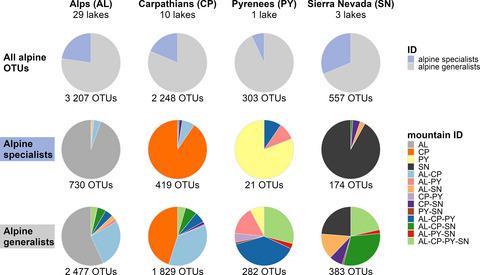当前位置:
X-MOL 学术
›
Microbiologyopen
›
论文详情
Our official English website, www.x-mol.net, welcomes your
feedback! (Note: you will need to create a separate account there.)
Patterns of protist distribution and diversification in alpine lakes across Europe
MicrobiologyOpen ( IF 3.9 ) Pub Date : 2021-07-26 , DOI: 10.1002/mbo3.1216 Janina C Vogt 1 , Jana L Olefeld 2 , Christina Bock 2 , Jens Boenigk 2 , Dirk C Albach 1
MicrobiologyOpen ( IF 3.9 ) Pub Date : 2021-07-26 , DOI: 10.1002/mbo3.1216 Janina C Vogt 1 , Jana L Olefeld 2 , Christina Bock 2 , Jens Boenigk 2 , Dirk C Albach 1
Affiliation

|
Biogeography in Europe is known to be crucially influenced by the large mountain ranges serving as biogeographical islands for cold-adapted taxa and geographical barriers for warm-adapted taxa. While biogeographical patterns are well-known for plants and animals in Europe, we here investigated diversity and distribution patterns of protist freshwater communities on a European scale (256 lakes) in the light of the well-studied post-glacial distribution patterns of macroorganisms. Thus, our study compared 43 alpine protist communities of lakes located in the Alps, Carpathians, Pyrenees, and the Sierra Nevada with that of surrounding lowland lakes. We verified altitudinal diversity gradients of freshwater protists with decreasing richness and diversity across altitudes similar to those observed for plants and animals. Alpine specialists and generalists could be identified differing significantly in richness and diversity, but hardly in occurrence and proportions of major taxonomic groups. High proportions of region-specific alpine specialists indicate an increased occurrence of distinct lineages within each mountain range and thus, suggested either separated glacial refugia or post-glacial diversification within mountain ranges. However, a few alpine specialists were shared between mountain ranges suggesting a post-glacial recolonization from a common lowland pool. Our results identified generalists with wide distribution ranges and putatively wide tolerance ranges toward environmental conditions as main drivers of protist diversification (specification) in alpine lakes, while there was hardly any diversification in alpine specialists.
中文翻译:

欧洲高山湖泊原生生物的分布和多样化模式
众所周知,欧洲的生物地理学受到大山脉的重大影响,山脉作为适应寒冷的类群的生物地理岛屿和适应温暖的类群的地理屏障。虽然欧洲植物和动物的生物地理模式是众所周知的,但我们在这里根据对大型生物体的充分研究的冰河后分布模式,研究了欧洲规模(256 个湖泊)原生生物淡水群落的多样性和分布模式。因此,我们的研究将位于阿尔卑斯山、喀尔巴阡山脉、比利牛斯山脉和内华达山脉的 43 个高山原生生物群落与周围低地湖泊的湖泊进行了比较。我们验证了淡水原生生物的海拔多样性梯度,其丰富度和多样性在不同海拔高度上呈递减趋势,与植物和动物观察到的情况类似。阿尔卑斯山专家和通才在丰富度和多样性方面存在显着差异,但在主要分类群的出现和比例方面几乎没有差异。高比例的特定地区高山专家表明每个山脉内不同谱系的出现有所增加,因此表明山脉内要么是独立的冰川避难所,要么是冰川后多样化。然而,一些高山专家在山脉之间共享,这表明冰川后从一个共同的低地水池重新殖民。我们的结果表明,具有广泛分布范围和对环境条件的广泛耐受范围的通才是高山湖泊原生生物多样性(规格)的主要驱动力,而高山专家几乎没有任何多样化。
更新日期:2021-07-26
中文翻译:

欧洲高山湖泊原生生物的分布和多样化模式
众所周知,欧洲的生物地理学受到大山脉的重大影响,山脉作为适应寒冷的类群的生物地理岛屿和适应温暖的类群的地理屏障。虽然欧洲植物和动物的生物地理模式是众所周知的,但我们在这里根据对大型生物体的充分研究的冰河后分布模式,研究了欧洲规模(256 个湖泊)原生生物淡水群落的多样性和分布模式。因此,我们的研究将位于阿尔卑斯山、喀尔巴阡山脉、比利牛斯山脉和内华达山脉的 43 个高山原生生物群落与周围低地湖泊的湖泊进行了比较。我们验证了淡水原生生物的海拔多样性梯度,其丰富度和多样性在不同海拔高度上呈递减趋势,与植物和动物观察到的情况类似。阿尔卑斯山专家和通才在丰富度和多样性方面存在显着差异,但在主要分类群的出现和比例方面几乎没有差异。高比例的特定地区高山专家表明每个山脉内不同谱系的出现有所增加,因此表明山脉内要么是独立的冰川避难所,要么是冰川后多样化。然而,一些高山专家在山脉之间共享,这表明冰川后从一个共同的低地水池重新殖民。我们的结果表明,具有广泛分布范围和对环境条件的广泛耐受范围的通才是高山湖泊原生生物多样性(规格)的主要驱动力,而高山专家几乎没有任何多样化。











































 京公网安备 11010802027423号
京公网安备 11010802027423号